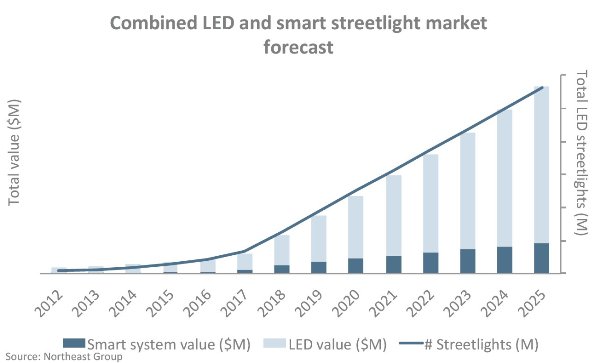Among cities and municipalities in the United States that have implemented Light-Emitting Diode (LED) streetlight projects, 95% were satisfied with the overall performance of the streetlights. The more efficient LED streetlights were found to save on average nearly 60% in combined energy and maintenance costs, according to a new survey published today by Washington, DC-based research firm Northeast Group, LLC. The firm surveyed nearly 100 cities and municipalities across the US that have implemented some form of LED streetlight initiatives. The results were published today in the new study "United States Smart Infrastructure: LED and Smart Street Lighting."
"LED streetlights are transforming cities and municipalities across the US," said Northeast Group. "Not only are LEDs helping save money through reduced energy and maintenance costs, but 95% of the cities and municipalities we surveyed said both they and residents were very happy with the performance and light quality of the new streetlights. Many reported that law enforcement officials in particular had praised the lights for improving visibility and public safety. The success of these LED projects is also helping to set the stage for more advanced 'smart' street lighting systems, which will reduce energy consumption by a further 20-30%. In total, the LED and smart street lighting markets are expected to reach a cumulative $4.7 billion in the US by 2025."

But there are also some challenges facing the market. The survey revealed that 45% of the respondents had funded their LED streetlight projects almost entirely with stimulus funding from the American Recovery and Reinvestment Act (ARRA). A further 36% relied on ARRA funding or other grants for at least a portion of their financing. As this stimulus funding recedes, financing for future LED streetlight projects has been more difficult to secure, despite the success of early projects. However, the price of LED streetlights is steadily falling and on track to hit parity with legacy technology within a few years. As a result, the payback period for these projects is becoming more favorable and within the reaches of budget-constrained cities and municipalities. As the LED streetlight business case continues to improve, the number of projects is expected to expand rapidly in the coming years.
Northeast Group's study identified nearly 400 US cities and municipalities that had either already begun or had considered installing LED streetlights. After conducting interviews with nearly 100 of them, the survey was able to draw conclusions such as the actual savings captured by pilot projects and full deployments, the public reaction, the most common financing mechanisms, and the vendors serving this market. Northeast Group found that over 25 vendors were already active in the US LED streetlight market and that, with expected strong growth, the market will continue to attract many vendors offering diverse solutions.
"Perhaps the most surprising finding in our survey was that most cities had only converted a small percentage of their streetlights to LEDs, even though they've been extremely popular," added Northeast Group. "It was hard to find any detractors from these projects, yet LED penetration remains below 1% of the overall streetlight population in the US. Certainly, some hurdles, such as financing, remain. But overall these findings show that the market has vast growth potential."
In addition to consuming less energy and reducing maintenance costs, LED streetlights also turn on and off nearly instantly and have dimming capability. This enables cities to install "smart" features to the streetlights, which further reduce energy consumption through dimming, improve billing, and enable remote monitoring features. Cities that have already installed communications networks for related smart grid infrastructure can take advantage of existing installations to lower overall costs.
"Smart streetlights are the logical next step," according to Northeast Group. "Current pilot projects such as in Chattanooga, Tennessee have demonstrated that smart streetlights improve safety while lowering costs. As more cities invest in LED streetlights and smart grid infrastructure, smart streetlights will help cities further reduce energy consumption. A majority of the cities in our survey were interested in pursuing smart streetlight systems in the future."





